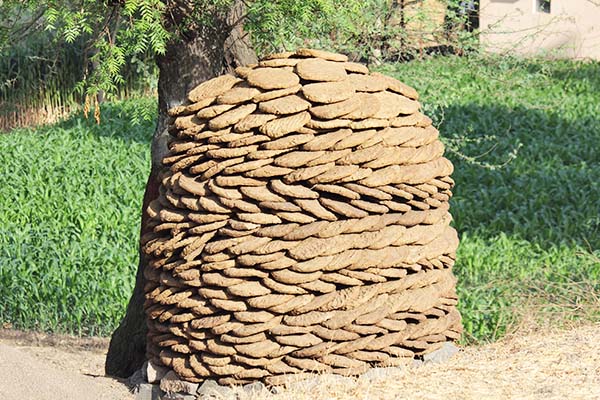Humans have used dried bovine dung (manure) as a fuel source since prehistoric times. In India, for example, many people burn cow or buffalo dung for cooking fuel. This bioresource provides a low-cost fuel as well as an efficient means of waste disposal. However, in rural India, the burning of dung is simultaneously a source of hazardous indoor and outdoor air pollution, resulting from the emission of fine particulates that are 2.5 micrometers or less in diameter (PM2.5). Such combustion byproducts are considered the most dangerous to human health, because PM2.5 can be inhaled deep into the lungs, impairing lung function as well as and affecting other organs, such as the heart and brain, or causing cancer. See also: Air pollution; Indoor air pollution

A less hazardous and more sustainable use of dung-for-energy is the production of biogas by anaerobic digestion, or decomposition. Biogas is a renewable energy source consisting of a mixture of about 60 percent methane (CH4) and 40 percent carbon dioxide (CO2) that is generated by the bacterial decomposition of organic wastes in the absence of oxygen. Biogas can be used for generating electricity, powering transportation vehicles, heating, or cooking. The waste product remaining after anaerobic digestion can be used as fertilizer. See also: Carbon dioxide; Electric power generation; Fertilizer; Methane; Sustainability
With an estimated 83 million dairy livestock, India has an abundance of dung. To benefit from this waste stream, India has constructed a biogas plant that is currently operating outside the city of Indore in Central India. In addition to dung, the plant will process other organic wastes, such as household food waste. When production reaches full capacity, the plant will process 500 metric tons (tonnes) of waste daily, including at least 25 tonnes of bovine dung. About half the CH4 produced is expected to power Indore’s public transportation system, and the remainder will be used by local industrial operations. In addition to the Indore plant, India has plans to construct waste-to-biogas plants in 75 other locations. See also: Dairy cattle production; Waste-to-energy
Converting dung to biogas could help decrease contributions to India’s air and water pollution, and potentially lessen global warming. At present, India produces about 44 percent of its energy from coal-fired power plants, according to the International Energy Agency (IEA). In addition to the global-warming contribution from burning this fossil fuel, air pollution inputs—including smog—from coal combustion is a major problem. A study published in The Lancet (January 2021) attributed 1.67 million deaths in 2019 to air pollution in India, accounting for about 18% of total deaths in the country. Furthermore, according to the Food and Agriculture Organization (FAO) of the United Nations, India emits about one million tonnes of CH4 from animal manure decomposition—that is, about 10 percent of global CH4 emissions attributed to manure decomposition. Methane is a powerful greenhouse gas with a greater potential for global warming compared to CO2. Thus, reducing methane generation is an important goal in the fight against climate change. Manure management from livestock farms is also critical in terms of water pollution, because livestock waste runoff results in excess nitrogen and phosphorus inputs, leading to poor water quality through eutrophication, as well as being a source of pathogens. In addition to improved air and water quality, and reduced greenhouse gas emissions, converting dung to biogas could also reduce the need for landfills as well as decrease energy costs, because biogas is less expensive than coal. See also: Coal; Eutrophication; Extreme weather events; Fertilizers and nutrient management; Global warming; Pathogen; Smog; Water pollution





